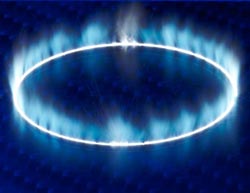
Lightweight Innovations Shaping Future Automobile Design

And the decisive factor for automobile construction of the future is to reduce the weight of the car. The Volkswagen AG is working together with the Laser Zentrum Hannover e.V. (LZH) and other partners on developing an innovative laser process for automated cutting of CFRP components, to make it possible to use this lightweight material for mass production.
Lightweight materials, which have both high strength and stiffness, are the materials for automobile construction of the future. This is due to safety reasons, which cannot be sacrificed in order to reduce weight.
Carbon fiber reinforced plastics (CFRP) have the characteristics that are needed. However, CFRP is a challenge in production technology, and currently, CFRP components are mainly used in the sports car sector and in small batch automotive production.
If cars based on CFRP are to be mass produced, then automated production technologies for cutting this lightweight material must be developed. Conventional technologies such as milling or waterjet cutting have process-based disadvantages, such as high tool wear or handling of water and abrasives, which cannot be solved technologically.
In the current joint project HolQueSt 3D, seven partners from industry and science, under the leadership of Volkswagen AG, are working together on developing a process for 3-D high-performance laser processing of CFRP lightweight structures. In comparison to conventional technologies, lasers can be used for non-contact, high-precision processing without tool wear, and simultaneously the process has high reproducibility and flexibility. Up to now, due to high temperatures, laser processing of CFRP causes damage in the processing zone. The main hurdles for using laser processing for CFRP are at present an incomplete understanding of the process, and the lack of sufficiently developed processes.
Based on a new, fiber-guided, high performance laser with pulse lengths in the nanosecond range (Trumpf Laser GmbH + Co. KG), the LZH is developing both a process especially geared towards CFRP applications and an optimized process monitoring system. A further obstacle to the use of lasers in lightweight construction is the process-based generation of particles and gasses, which are partially hazardous to health. Together with Jenoptik Katasorb GmbH, the LZH is working on a remedy, by finding a suitable method for treatment and filtering, based on previous characterisation of the process emissions.
These concepts should be used to provide large-scale CFRP processing adapted to the demands of the automobile industry. Thus, resource efficient, lightweight construction concepts could soon find their way into today’s automotive generation.
HolQueSt 3D is financially supported by the German Ministry of Education and Research (BMBF), within the framework of the funding initiative “Photonic Processes and Tools for Resource-Efficient Lightweight Construction”, with funding of approximately 4 Million Euros from a total amount of 7 Million Euros for the whole project. Project partners are Volkswagen AG, Jenoptik Katasorb GmbH, Trumpf Laser GmbH+Co. KG, Invent GmbH, KMS Automation GmbH, TU Clausthal and the Laser Zentrum Hannover e.V.
Contact:
Laser Zentrum Hannover e.V. (LZH)
Lena Bennefeld
Hollerithallee 8
D-30419 Hannover
Tel.: +49 511 2788-238
Fax: +49 511 2788-100
E-Mail: l.bennefeld@lzh.de
The Laser Zentrum Hannover e.V. (LZH) carries out research and development in the field of laser technology and is supported by the Ministry of Economic Affairs, Labour and Transport of the State of Lower Saxony (Niedersächsisches Ministerium für Wirtschaft, Arbeit und Verkehr).












